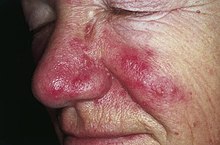| Rosacea | |
|---|---|
| Other names | Acne rosacea |
 | |
| Rosacea over the cheeks and nose[1] | |
| Pronunciation | |
| Specialty | Dermatology |
| Symptoms | Facial redness, swelling, and small and superficial dilated blood vessels[2][3] |
| Complications | Rhinophyma[3] |
| Usual onset | 30–50 years old[2] |
| Duration | Long term[2] |
| Types | Erythematotelangiectatic, papulopustular, phymatous, ocular[2] |
| Causes | Unknown[2] |
| Risk factors | Family history[3] |
| Diagnostic method | Based on symptoms[2] |
| Differential diagnosis | Acne, perioral dermatitis, seborrhoeic dermatitis, dermatomyositis, lupus[2] |
| Medication | Antibiotics either by mouth or applied to the skin[3] |
| Frequency | ~5%[2] |
Rosacea is a long-term skin condition that typically affects the face.[2][3] It results in redness, pimples, swelling, and small and superficial dilated blood vessels.[2] Often, the nose, cheeks, forehead, and chin are most involved.[3] A red, enlarged nose may occur in severe disease, a condition known as rhinophyma.[3]
The cause of rosacea is unknown.[2] Risk factors are believed to include a family history of the condition.[3] Factors that may potentially worsen the condition include heat, exercise, sunlight, cold, spicy food, alcohol, menopause, psychological stress, or steroid cream on the face.[3] Diagnosis is based on symptoms.[2]
While not curable, treatment usually improves symptoms.[3] Treatment is typically with metronidazole, doxycycline, minocycline, or tetracycline.[4] When the eyes are affected, azithromycin eye drops may help.[5] Other treatments with tentative benefit include brimonidine cream, ivermectin cream, and isotretinoin.[4] Dermabrasion or laser surgery may also be used.[3] The use of sunscreen is typically recommended.[3]
Rosacea affects between 1% and 10% of people.[2] Those affected are most often 30 to 50 years old and female.[2] Fair-skinned people seem to be more commonly affected.[6] The condition was described in The Canterbury Tales in the 1300s, and possibly as early as the 200s BC by Theocritus.[7][8]
- ^ Sand M, Sand D, Thrandorf C, Paech V, Altmeyer P, Bechara FG (4 June 2010). "Cutaneous lesions of the nose". Head & Face Medicine. 6: 7. doi:10.1186/1746-160X-6-7. PMC 2903548. PMID 20525327.
- ^ a b c d e f g h i j k l m n Tüzün Y, Wolf R, Kutlubay Z, Karakuş O, Engin B (February 2014). "Rosacea and rhinophyma". Clinics in Dermatology. 32 (1): 35–46. doi:10.1016/j.clindermatol.2013.05.024. PMID 24314376.
- ^ a b c d e f g h i j k l "Questions and Answers about Rosacea". www.niams.nih.gov. April 2016. Archived from the original on 13 May 2017. Retrieved 5 June 2017.
- ^ a b van Zuuren EJ, Fedorowicz Z (September 2015). "Interventions for rosacea: abridged updated Cochrane systematic review including GRADE assessments". The British Journal of Dermatology. 173 (3): 651–62. doi:10.1111/bjd.13956. PMID 26099423. S2CID 41303286.
- ^ "Rosacea First choice treatments". Prescrire International. 182: 126–128. May 2017. Archived from the original on 10 September 2017.
- ^ Rainer BM, Kang S, Chien AL (2017). "Rosacea: Epidemiology, pathogenesis, and treatment". Dermatoendocrinol. 9 (1): e1361574. doi:10.1080/19381980.2017.1361574. PMC 5821167. PMID 29484096.
- ^ Zouboulis CC, Katsambas AD, Kligman AM (2014). Pathogenesis and Treatment of Acne and Rosacea. Springer. p. XXV. ISBN 978-3-540-69375-8. Archived from the original on 10 September 2017.
- ^ Schachner LA, Hansen RC (2011). Pediatric Dermatology E-Book. Elsevier Health Sciences. p. 827. ISBN 978-0-7234-3665-2. Archived from the original on 10 September 2017.